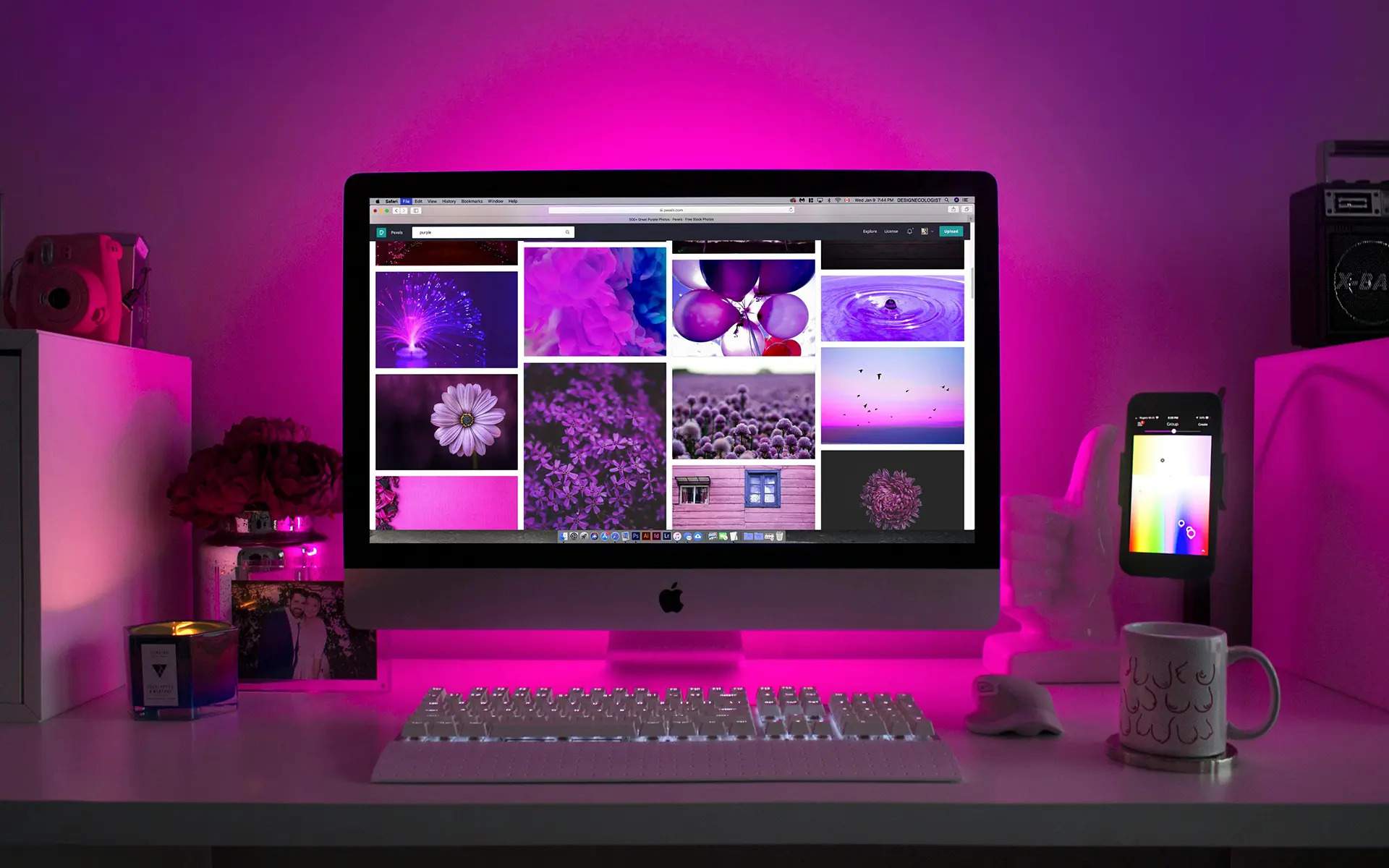Tech is Human Nature: Reframing Your Relationship With Technology
Technology brings very real harms—too often, this means we don’t let ourselves enjoy its positives. According to a mindful tech designer, coming to understand our own nature can help us reframe our relationship with tech, liberating our attention in...

Key Points:
Technology is disruptive and distracting, yet it also has many useful roles in our life. Instead of feeling guilty or ashamed for relying on technology, accept tech and learn to use it well. Technology isn’t separate from human nature—it is part of our nature. Clarifying why you want a healthier relationship with tech can help you shift your habits.When I first started meditating, I was banging my head against the wall, trying to silence my mind. I was so harsh with myself because I was desperate. I was numb and lost, and I thought that if only I could stop thinking, everything would be bliss. So I gritted my teeth and tried to force my mind to shut up.
My practice opened up when I gave up on trying so hard to clear my mind. I learned to embrace thoughts as a natural and expected part of the human experience, because they are. Sometimes challenging, sometimes useful, sometimes silly—I accept my thoughts. I let them come and go as if they were clouds passing in the sky. Turns out the idea that thinking is a problem was just another passing thought.
Many of us get caught in a similar pattern with our tech. In the modern world, trying to completely stop using technology feels a lot like trying to stop thinking. Some inspirational quote from a yoga teacher on social media tells you to “clear your mind,” and not only is that impossible, but it also generates a ton of unnecessary guilt and shame. When more thoughts inevitably come, you beat yourself up for failing. You start to think you’re broken.
There are technologies out there that respect your attention, and even some that restore it, but they are certainly not the norm. We’re mostly swimming in a cornucopia of mindless, triggering tech that narrows our awareness and erodes our patience.
The more tech disrupts our lives, the more we blame it for everything. We get desperate for freedom and try to disconnect. But tech is so integrated into modern life that it’s not long before we need to reconnect. The pendulum swings back and forth as we spiral into shame and self-judgment for being so attached to the very devices we depend on.
Mindfulness is a way out, and acceptance is the first step.
A Middle Way with Tech
Blaming technology for all our problems is the same mistake we make when we try to force ourselves to stop thinking. In the same way meditators learn to befriend their thoughts, we can work gently and gradually toward finding a middle way with technology. It won’t necessarily be easy, but awareness is mysterious, powerful, and always present. Tap into it directly and you just might be able to conquer a few tugs from devious little apps that are trying to manipulate you. If that feels impossible, you may need formal meditation to train up in meta-awareness. If even that feels impossible, it might be time to set boundaries or delete a few apps.
Certainly, corporations need to design more ethically, scientists need to continue researching the impact on mental health and well-being, and lawmakers need to consider if regulation can help. But in the meantime, you are not powerless. Right here, right now, you can stand up for your right to point your mind in whichever direction you damn well please. Pessimists who claim we are all victims of forces larger than ourselves love to convince everyone they’re realists, but this is a battle being waged in the mundane moments of everyday life. You have choice. Even if you don’t have the power to influence your family, community, organization, or lawmakers, you don’t have to give up on your own mind.
Whether you choose to put the devices away today, or whether you choose to spend the whole day in front of a screen, there’s nothing to be ashamed of. A little bit of guilt can help you stick to your intentions, but if you’re constantly feeling bad about yourself, there are better ways. It’s easy to drown in guilt when you wake up from a digital trance and realize you’ve spent the whole day online. It’s just as easy to feel guilty for disconnecting, missing messages, or falling behind on social media and news.
Blaming technology for all our problems is the same mistake we make when we try to force ourselves to stop thinking.
Is there ever a moment to just . . . not feel guilty? Even when glued to a screen, you are worthy just as you are. No shame necessary. No need to beat up on yourself. Accept the part of you that loves tech and the part that wants to lock it away. While you’re at it, accept your loved ones, even when they ignore you for their screens. No need to harshly punish your kids, or shame other people just for living a modern life. Accept people both younger and older, even if their relationship with tech looks alien to you.
From this foundation of acceptance, pay close attention to how tech shapes you. Forgive yourself when it captures you, because it most definitely will. See clearly how it happened, and you can get better at seamlessly moving between offline and online worlds without getting stuck. It is possible to live a mindful digital life.
You don’t have to retreat to the mountains or switch to a dumbphone to find balance. By all means, take an offline day when you need it. Or head off to a retreat center. Hell, go to India and find yourself. I certainly got a lot out of retreating over the years. Time apart from your everyday routine can help you break compulsive habits and find new perspectives. But don’t let the benefits of a temporary digital detox distract you from learning how to use tech well in everyday life.
What We Forget About Nature
When we get overwhelmed, we often say we want to “get out in nature” or go on a “nature walk,” but we are just as natural as the birds and the trees. So is the fly buzzing around your garbage can and the mold growing on old fruit. Nature is not somewhere out there. It’s everywhere. So where exactly are we trying to go?
When we get overwhelmed, we often say we want to “get out in nature” or go on a “nature walk,” but we are just as natural as the birds and the trees. So is the fly buzzing around your garbage can and the mold growing on old fruit. Nature is not somewhere out there. It’s everywhere. So where exactly are we trying to go?
We think of our modern lives as artificial, but is that really true? For the past two years, in the spring, a robin has built a nest on top of the light fixture beside my front door. Every time we step out of our home, she squawks to protect her hatchlings. My little boy and I love keeping tabs on Mrs. Robinson.
Inside the house holding up that nest, my family and I cook in a sophisticated kitchen and fiddle with temperature controls. We watch TV, use social media, play video games, and work on laptops. It all feels very different from a nest, but the way we source materials from our natural environment to build these modern lives is not so different from a bird gathering sticks, though certainly on a different scale.
We think of our modern lives as artificial, but is that really true?
It can be useful to reframe our technological wonders as natural. We imagine our civilization as somehow removed from the wild world. We love to think we’re special, but you probably accept that you are a part of nature. So why wouldn’t your nest be natural too, just like Mrs. Robinson’s?
If this feels off, you might be idealizing Mother Nature. Remember, she can be just as destructive as she can be harmonious. There is infinite wonder in the ocean, trees, and skies, but there are also viral infections, natural disasters, and predators killing their prey. When I describe our tech as natural, I’m certainly not saying it’s all good.
These days, we yell at our kids to put away their phones while lost in our own. We glance to check a text and end up scrolling for hours. We go down rabbit holes on social until we feel inadequate. We skim polarizing headlines until it feels like the world is on fire. We compulsively reply to work emails on our day off.
Some days we feel more used than user.
But tech is also beautiful, wonderful, and awe-inspiring. It connects us in ways previously thought impossible. It can bring us so much joy. It can help us be productive and organized. We can express ourselves like never before. I use it to stay in touch and collaborate with people across the planet. I use it to listen to and make music. And yes, I even use it to meditate.
Tech as Human Nature
You might love smartphones and the social internet. If that’s you, it can be hard to admit to the problems without getting defensive. Or you might be someone who hates the way your devices interfere with every moment. You might feel like they’re running your life—or worse, ruining your life. You might even notice how they’re causing harm to people you care about. If you’re the type who wants to escape and live on a mountain somewhere, it can be hard to admit how amazing technology can be.
Accepting tech as part of who we are means acknowledging that it’s not some foreign, alien invader. It’s neither good nor evil. It’s us. Even the AIs that seem more independent than ever before depend on the text and images we feed them. They don’t exist without us. The internet is a powerful extension of our minds. It amplifies our flaws as much as our strengths. To have a better relationship with technology, we need a better relationship with ourselves.
Accepting tech as part of who we are means acknowledging that it’s not some foreign, alien invader. It’s neither good nor evil. It’s us.
This is where the issue becomes spiritual.
Tech isn’t just nature, it’s human nature. And these days, it’s getting exhausting. With our minds constantly plugged in to amplifiers, it’s never been more important to find balance. Our tech mirrors our own values back at us in a distorted way, often causing the opposite effect of what we intend. It isolates us as much as it connects us. It numbs us as much as it inspires us. It bores us as much as it entertains us.
Sometimes we just want to run away from all the emails, feeds, and desperate pleas to like and subscribe. We want to escape the news. And social media. And online shopping and porn and video games and those group chats where everyone keeps misunderstanding each other. When we say we want to “get out in nature,” what we really mean is that we want to get away from human nature. We want to escape who we are.
Understandable. Our brains are plugged in to a billion other brains, each having tens of thousands of thoughts per day. Many organize to profit from all this, designing greedy, distracting, stressful apps—weapons of mass distraction. On the other hand, many also work to make the hive mind useful, fun, and powerful. Unfortunately, both sides produce a ton of unintended consequences.
You Always Have a Choice
Experts are studying technology’s effects on our mind, trying to regulate its use and establish standards for designing ethical, humane tech. Where does that leave the rest of us? What if you’re not a decision-maker? What if you don’t have any influence on science, government, media, or tech? Do you just have to sit and wait, hoping they figure it out? Of course not.
Our job is to become aware of how tech affects us and those we care about. We can choose to be better users of technology in everyday life. We can become more discerning about the tech we pay attention to, setting boundaries around apps that exploit us, but also unapologetically delighting in the experiences that bring us joy, improve our lives, and transform us for the better.
It feels like a big job, especially when compulsive screen time can feel completely out of our control. Tech companies can be manipulative. Unethical decision-makers need to face consequences. Still, there’s no need to give up and wait for someone to save you. With tech constantly demanding our attention and overwhelming us, your well-being is becoming more and more dependent on the quality of your relationship with it. If mindfulness has taught me anything, it’s that you always have a choice in how you relate to whatever you experience.
A Practice for Tuning In to the Joy of Tech
When you’ve got a moment to explore, try fully enjoying a technology that makes you happy. It’s so easy to get wrapped up in the idea of what you should and shouldn’t be doing. This little practice is an antidote to that. Let yourself enjoy something!
Choose a technology that brings you joy. It can be hard to stay present with something that changes a lot, so ideally, choose something with a slower pace. For example, if you love stand-up comedy, find a video of a longer performance instead of a bunch of short clips. Put away all your distractions. Set up your experience by queuing up the tech and putting away anything that might distract you. So if you’re watching a TV show, put your phone and tablet away, and maybe even ask anyone you live with for some privacy. Enjoy the experience fully. If you want, you can start with a few deep breaths, maybe even with your eyes closed. When you’re ready, start interacting with the tech and see if you can stay present with how it makes you feel. It helps to take it slow. For example, if you’re playing a video game, take your time and notice any feelings, thoughts, or impulses that might arise as you play. Let go of shame, guilt, and doubt. If any thoughts or feelings come up about how you might be wasting your time, how weird this practice feels, or even your ability to stay aware, let that come and go. No need to resist it, but don’t dive into it either. Stay with your moment-to-moment experience of the technology. Let positive emotions flow. If any positive thoughts or feelings come up, pay close attention to them and let them flower. So for example, if you’re listening to a podcast and someone says something funny, see if you can fully enjoy that without reservation. Stop when you’re ready, but no sooner. Some experiences have a natural end, like a TV show. Others you might need to find your own end for, such as browsing a social media feed. In any case, avoid ending the practice at the first moment of resistance. See if you can give it time to run its course. Ride a few ups and downs. When you’re done, turn off your tech and take a moment to breathe, reflect, or meditate before moving on.Excerpt from RECLAIM YOUR MIND: Seven Strategies to Enjoy Tech Mindfully by Jay Vidyarthi, published by Still Ape Press (February 2025). Copyright © 2025 by Jay Vidyarthi. Reprinted with the permission of the author.

 Fransebas
Fransebas 






























